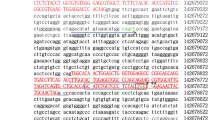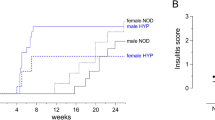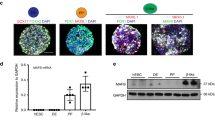Abstract
Nonobese diabetic (NOD) mice provide an excellent model of type 1 diabetes. The genetic contribution to this disease is complex, with more than 20 loci implicated in diabetes onset. One of the challenges for researchers using the NOD mouse model (and, indeed, other models of spontaneous autoimmune disease) has been the high density of sequence variation within candidate chromosomal segments. Furthermore, the scope for analyzing many putative disease loci via gene targeting has been hampered by the lack of NOD embryonic stem (ES) cells. We describe here the derivation of NOD ES cell lines capable of generating chimeric mice after stable genetic modification. These NOD ES cell lines also show efficient germline transmission, with offspring developing diabetes. The availability of these cells will not only enable the dissection of closely linked loci and the role they have in the onset of type 1 diabetes but also facilitate the generation of new transgenics.
This is a preview of subscription content, access via your institution
Access options
Subscribe to this journal
Receive 12 print issues and online access
$209.00 per year
only $17.42 per issue
Buy this article
- Purchase on Springer Link
- Instant access to full article PDF
Prices may be subject to local taxes which are calculated during checkout




Similar content being viewed by others
References
Redondo, M.J., Fain, P.R. & Eisenbarth, G.S. Genetics of type 1A diabetes. Recent Prog. Horm. Res. 56, 69–89 (2001).
Kikutani, H. & Makino, S. The murine autoimmune diabetes model: NOD and related strains. Adv. Immunol. 51, 285–322 (1992).
Wicker, L.S., Todd, J.A. & Peterson, L.B. Genetic control of autoimmune diabetes in the NOD mouse. Annu. Rev. Immunol. 13, 179–200 (1995).
Serreze, D.V. & Leiter, E.H. Genes and cellular requirements for autoimmune diabetes susceptibility in nonobese diabetic mice. Curr. Dir. Autoimmun. 4, 31–67 (2001).
Brook, F.A. et al. The derivation of highly germline-competent embryonic stem cells containing NOD-derived genome. Diabetes 52, 205–208 (2003).
Nagafuchi, S. et al. Establishment of an embryonic stem (ES) cell line derived from a non-obese diabetic (NOD) mouse: in vivo differentiation into lymphocytes and potential for germ line transmission. FEBS Lett. 455, 101–104 (1999).
Yang, W. et al. Pluripotin combined with LIF greatly promotes the derivation of ES cell lines from refractory strains. Stem Cells 27, 383–389 (2009).
Arai, S., Minjares, C., Nagafuchi, S. & Miyazaki, T. Improved experimental procedures for achieving efficient germ line transmission of nonobese diabetic (NOD)-derived embryonic stem cells. Exp. Diabesity Res. 5, 219–226 (2004).
Ying, Q.L. et al. The ground state of embryonic stem cell self-renewal. Nature 453, 519–523 (2008).
Buehr, M. et al. Capture of authentic embryonic stem cells from rat blastocysts. Cell 135, 1287–1298 (2008).
Silva, J. & Smith, A. Capturing pluripotency. Cell 132, 532–536 (2008).
Li, P. et al. Germline competent embryonic stem cells derived from rat blastocysts. Cell 135, 1299–1310 (2008).
Solter, D. & Knowles, B.B. Immunosurgery of mouse blastocyst. Proc. Natl. Acad. Sci. USA 72, 5099–5102 (1975).
McClive, P.J. & Sinclair, A.H. Rapid DNA extraction and PCR-sexing of mouse embryos. Mol. Reprod. Dev. 60, 225–226 (2001).
Bradley, A., Evans, M., Kaufman, M.H. & Robertson, E. Formation of germ-line chimaeras from embryo-derived teratocarcinoma cell lines. Nature 309, 255–256 (1984).
Brode, S., Raine, T., Zaccone, P. & Cooke, A. Cyclophosphamide-induced type-1 diabetes in the NOD Mouse is associated with a reduction in CD4+CD25+Foxp3+ regulatory T cells. J. Immunol 177, 6603–6612 (2006).
Guo, G. et al. Klf4 reverts developmentally programmed restriction of ground state pluripotency. Development 136, 1063–1069 (2009).
Wang, W. et al. Chromosomal transposition of PiggyBac in mouse embryonic stem cells. Proc. Natl. Acad. Sci. USA 105, 9290–9295 (2008).
Ying, Q.L., Stavridis, M., Griffiths, D., Li, M. & Smith, A. Conversion of embryonic stem cells into neuroectodermal precursors in adherent monoculture. Nat. Biotechnol. 21, 183–186 (2003).
Acknowledgements
We would like to thank G. Guo (Wellcome Trust Centre for Stem Cell Research) for providing the PiggyBac DsRED vector used in our studies, R. Zamoyska (University of Edinburgh) for the FITC-labeled antibody to H-2Kb and K. Tomonari (Fukui Medical School) for the KT3 antibody. We thank N. Holmes and J. Cooke for careful reading of our manuscript. We thank C. Bland and Y. Sawyer for technical assistance. We are grateful to the Wellcome Trust and the Medical Research Council for supporting this research.
Author information
Authors and Affiliations
Contributions
J.N. contributed to the design of the experiments, supervised and conducted the experiments and was involved in writing the manuscript;, K.J. helped conduct the experiments and generated the genetically modified NOD ES cells; J.M.P. helped conduct experiments, conducted all of the in vivo and ex vivo NOD work and generated the manuscript figures; S.A.N. conducted all of the microsatellite experiments in Figures 2 and 3; M.R. helped in the conduct of experiments in Figure 1; W.M. performed the blastocyst injections; A.S. contributed to the design of the experiments and the review of the manuscript; and A.C. contributed to the design of the experiments and supervised and was involved in writing the manuscript.
Corresponding author
Supplementary information
Rights and permissions
About this article
Cite this article
Nichols, J., Jones, K., Phillips, J. et al. Validated germline-competent embryonic stem cell lines from nonobese diabetic mice. Nat Med 15, 814–818 (2009). https://doi.org/10.1038/nm.1996
Received:
Accepted:
Published:
Issue Date:
DOI: https://doi.org/10.1038/nm.1996
This article is cited by
-
Modelling in vitro gametogenesis using induced pluripotent stem cells: a review
Cell Regeneration (2023)
-
Generation of pulsatile ERK activity in mouse embryonic stem cells is regulated by Raf activity
Scientific Reports (2023)
-
Epigenetic integrity of paternal imprints enhances the developmental potential of androgenetic haploid embryonic stem cells
Protein & Cell (2022)
-
Two base pair deletion in IL2 receptor γ gene in NOD/SCID mice induces a highly severe immunodeficiency
Laboratory Animal Research (2020)
-
Derivation of stable embryonic stem cell-like, but transcriptionally heterogenous, induced pluripotent stem cells from non-permissive mouse strains
Mammalian Genome (2020)



